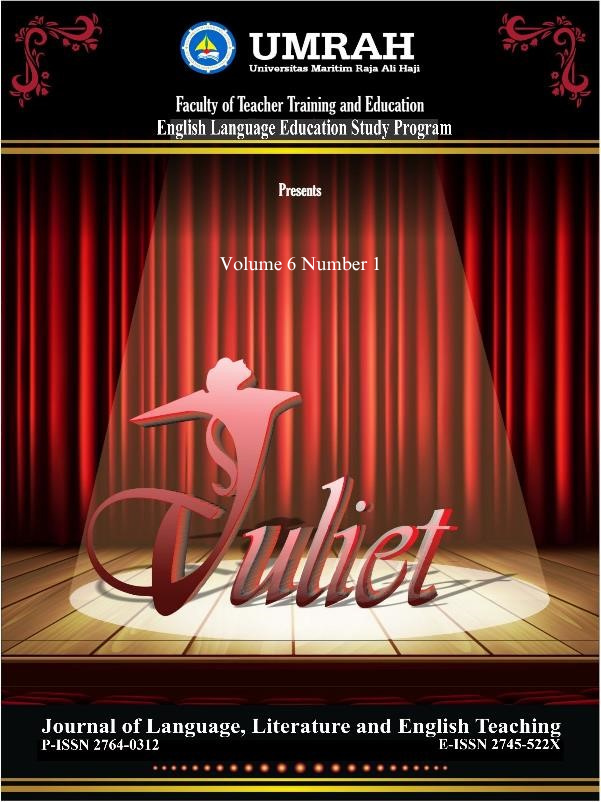FROM PLAYLIST TO PRONUNCIATION: EXPLORING STUDENTS’ VIEWS ON SPOTIFY IN LANGUAGE LEARNING
DOI:
https://doi.org/10.31629/juliet.v6i2.7591Keywords:
Students’ Perceptions, Spotify Application, Pronunciation ImprovementAbstract
This study explores students’ perceptions of using the Spotify application as a tool to improve English pronunciation. Conducted at SMA Negeri 4 Tanjungpinang, the research involved 32 students who responded to a structured questionnaire. The aim was to understand how students engage with English songs on Spotify and how they perceive its effectiveness in supporting pronunciation learning. The results show that the majority of students held positive perceptions, viewing Spotify as a helpful resource for pronunciation improvement through repeated listening and exposure to native speaker models. A significant 78.13% of students reported using Spotify specifically to enhance pronunciation, with many focusing on suprasegmental features such as intonation (75%), stress (80.65%), and rhythm (77.42%). These elements are essential for achieving natural-sounding and intelligible English speech. However, only 41.94% of students reported noticeable improvement, indicating that passive listening may not be sufficient for pronunciation development. This suggests that while Spotify provides accessible and authentic input, it must be supported by structured strategies such as repetition, shadowing, and phonetic awareness activities. Furthermore, 59.38% of students expressed willingness to recommend using Spotify for pronunciation, showing moderate endorsement. Pop songs were identified as the most helpful genre due to their clear lyrics, repetitive patterns, and moderate tempo. These findings underscore the potential of music-based learning as a motivational and effective supplement to formal pronunciation instruction. To maximize results, educators are encouraged to integrate music platforms like Spotify into classroom activities that promote active listening and pronunciation practice.
References
Albaladejo, S. A., Coyle, Y., & de Larios, J. R. (2018). Songs, stories, and vocabulary acquisition in preschool learners of English as a foreign language. System, 76, 116–128.
Arsyawan, R. A., Shodiq, J., & Wulandri, S. (2023). Students’perceptions On Spotify Application In Improving English Pronunciation. Didaktik: Jurnal Ilmiah PGSD STKIP Subang, 9(04), 2234-2242.
Bai, Y., Gu, X., & Chen, W. (2020). Using technology to promote flexible learning in a blended course. Internet and Higher Education, 45, 100710.
Fonseca-Mora, M. C., & Fernández-García, A. (2022). EFL learners’ speaking proficiency and its connection to emotional understanding, willingness to communicate and musical experience. Language Teaching Research, 26(1), 124–140.
Fonseca-Mora, M. C., & Toscano-Fuentes, C. M. (2016). Melodies, Rhythm and Cognition in Foreign Language Learning. Cambridge Scholars Publishing.
Fonseca-Mora, M. C., Toscano-Fuentes, C., & Wermke, K. (2011). Melodies that help: The relation between language aptitude and musical intelligence. Anglistik. International Journal of English Studies, 22(1), 101–118.
Fouz-González, J. (2020). Using apps for pronunciation training: An empirical evaluation of the English File pronunciation app. Language Learning & Technology, 24(1), 62–85.
Gilakjani, A. P. (2012). The significance of pronunciation in English language teaching. English Language Teaching, 5(4), 96–107.
Gilakjani, A. P. (2016). English Pronunciation Instruction: A Literature Review. International Journal of Research in English Education, 1(1), 1–6.
Ginting, S. A. (2019). Shadowing technique; Teaching listening skill to ESOL learners in university. SALTeL Journal (Southeast Asia Language Teaching and Learning), 2(2), 83–87.
Goh, C. C. M. (2018). Teaching English to second language learners in academic contexts. In J. Newton, D. Ferris, C. Goh, W. Grabe, & F. Stoller (Eds.), Teaching English to Second Language Learners in Academic Contexts (pp. 1–20). Routledge.
Ilyas, A. A., & Kaniadewi, N. (2023). Students’ perception on the use of Spotify to improve students’ pronunciation. INSPIRING, 119-132.
Kaur, S. (2014). Developing speaking skills using songs. Journal of ELT and Applied Linguistics, 2(1), 35–42.
Nguyen, L. T. (2021). Vietnamese EFL learners' pronunciation needs: A teaching and learning perspective. Heliyon, 7(7), e07550.
Pardede, P. (2018). Improving EFL Students’ English Pronunciation by Using the Explicit Teaching Approach. Journal of English Teaching, 4(3), 143–155.
Pourhosein Gilakjani, A. (2016). English pronunciation instruction: A literature review. International Journal of Research in English Education, 1(1), 1–6.
Purba, J., Natalia, L., & Sapira, L. (2023). The Students’ Perception on Using Spotify Towards Their English Pronunciation. ENLIT Journal, 3 (1), 37–49.
Rahimi, M., & Abedini, A. (2012). The interface between EFL learners’ self-efficacy concerning listening comprehension and listening proficiency. Novitas-ROYAL (Research on Youth and Language), 6(1), 1–13.
Rosell-Aguilar, F. (2017). User evaluation of language learning mobile applications: A case study with learners of Spanish. China Central Radio & TV University Press.
Saito, K., & Plonsky, L. (2019). Effects of second language pronunciation teaching revisited: A proposed measurement framework and meta‐analysis. Language Learning, 69(3), 652–708.
Sardegna, V. G. (2022). Evidence in favor of a strategy-based model for English pronunciation instruction. Language Teaching, 55(3), 363–378.
Sardegna, V. G., Lee, J., & Kusey, C. (2018). Self‐efficacy, attitudes, and choice of strategies for English pronunciation learning. Language Learning, 68(1), 83–114.
Sevik, M. (2011). Teacher views about using songs in teaching English to young learners. Educational Research and Reviews, 6(21), 1027–1035.
Supeno. (2018). Using Songs to Improve Students' Pronunciation. The 65th TEFLIN International Conference, Universitas Negeri Makassar.
Wen, Z., Biedroń, A., & Skehan, P. (2017). Foreign language aptitude theory: Yesterday, today and tomorrow. Language Teaching, 50(1), 1–31
Downloads
Published
Issue
Section
License
Copyright (c) 2025 Sukma Daniyati, Suwaebatul Aslamiya, Handrianto Saputra

This work is licensed under a Creative Commons Attribution 4.0 International License.





